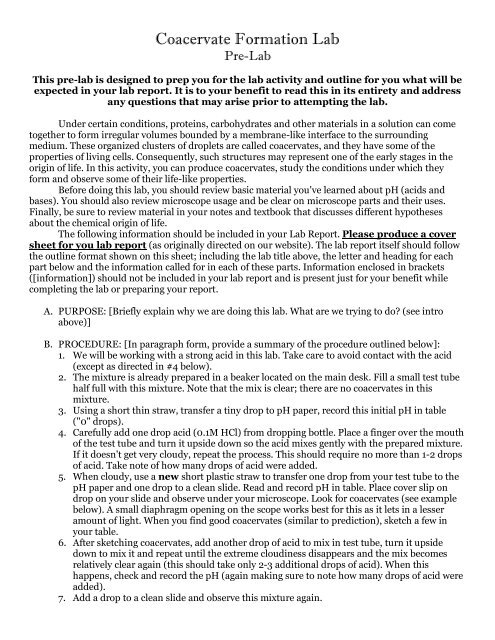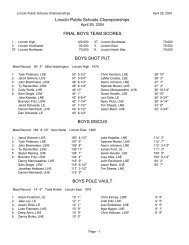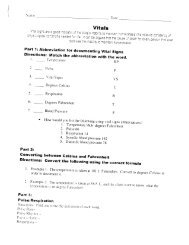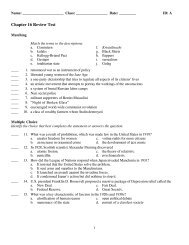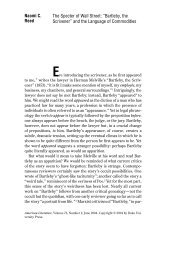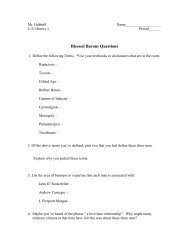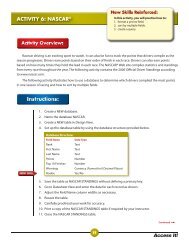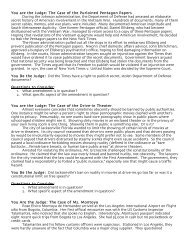Coacervate Formation Lab
Coacervate Formation Lab
Coacervate Formation Lab
You also want an ePaper? Increase the reach of your titles
YUMPU automatically turns print PDFs into web optimized ePapers that Google loves.
<strong>Coacervate</strong> <strong>Formation</strong> <strong>Lab</strong><br />
Pre-<strong>Lab</strong><br />
This pre-lab is designed to prep you for the lab activity and outline for you what will be<br />
expected in your lab report. It is to your benefit to read this in its entirety and address<br />
any questions that may arise prior to attempting the lab.<br />
Under certain conditions, proteins, carbohydrates and other materials in a solution can come<br />
together to form irregular volumes bounded by a membrane-like interface to the surrounding<br />
medium. These organized clusters of droplets are called coacervates, and they have some of the<br />
properties of living cells. Consequently, such structures may represent one of the early stages in the<br />
origin of life. In this activity, you can produce coacervates, study the conditions under which they<br />
form and observe some of their life-like properties.<br />
Before doing this lab, you should review basic material you've learned about pH (acids and<br />
bases). You should also review microscope usage and be clear on microscope parts and their uses.<br />
Finally, be sure to review material in your notes and textbook that discusses different hypotheses<br />
about the chemical origin of life.<br />
The following information should be included in your <strong>Lab</strong> Report. Please produce a cover<br />
sheet for you lab report (as originally directed on our website). The lab report itself should follow<br />
the outline format shown on this sheet; including the lab title above, the letter and heading for each<br />
part below and the information called for in each of these parts. Information enclosed in brackets<br />
([information]) should not be included in your lab report and is present just for your benefit while<br />
completing the lab or preparing your report.<br />
A. PURPOSE: [Briefly explain why we are doing this lab. What are we trying to do? (see intro<br />
above)]<br />
B. PROCEDURE: [In paragraph form, provide a summary of the procedure outlined below]:<br />
1. We will be working with a strong acid in this lab. Take care to avoid contact with the acid<br />
(except as directed in #4 below).<br />
2. The mixture is already prepared in a beaker located on the main desk. Fill a small test tube<br />
half full with this mixture. Note that the mix is clear; there are no coacervates in this<br />
mixture.<br />
3. Using a short thin straw, transfer a tiny drop to pH paper, record this initial pH in table<br />
("0" drops).<br />
4. Carefully add one drop acid (0.1M HCl) from dropping bottle. Place a finger over the mouth<br />
of the test tube and turn it upside down so the acid mixes gently with the prepared mixture.<br />
If it doesn't get very cloudy, repeat the process. This should require no more than 1-2 drops<br />
of acid. Take note of how many drops of acid were added.<br />
5. When cloudy, use a new short plastic straw to transfer one drop from your test tube to the<br />
pH paper and one drop to a clean slide. Read and record pH in table. Place cover slip on<br />
drop on your slide and observe under your microscope. Look for coacervates (see example<br />
below). A small diaphragm opening on the scope works best for this as it lets in a lesser<br />
amount of light. When you find good coacervates (similar to prediction), sketch a few in<br />
your table.<br />
6. After sketching coacervates, add another drop of acid to mix in test tube, turn it upside<br />
down to mix it and repeat until the extreme cloudiness disappears and the mix becomes<br />
relatively clear again (this should take only 2-3 additional drops of acid). When this<br />
happens, check and record the pH (again making sure to note how many drops of acid were<br />
added).<br />
7. Add a drop to a clean slide and observe this mixture again.
C. PREDICTIONS: [This will need to be completed before you are able to do the lab and should be<br />
based on the procedure that has been described above. You will then copy items 1, 3 and 4 in<br />
this section into your lab report (item 2 will be included in section D. Results).]<br />
1. <strong>Coacervate</strong>s expected: [copy here the picture of coacervates as shown below]<br />
Example <strong>Coacervate</strong> Predicted <strong>Coacervate</strong> (should not look identical)<br />
2. Expected pH levels: [See "pH of Mix Prediction" column in the "Results" table below.<br />
Assume pH of the original mix will be about 5; indicate (in that column) the pH expected as<br />
acid is added]<br />
3. <strong>Coacervate</strong> formation expected at pH level:<br />
4. <strong>Coacervate</strong>s expected to disappear (as more acid is added) at pH level:<br />
D. RESULTS: [Copy this data table into your <strong>Lab</strong> Report.]<br />
Drops HCl<br />
added<br />
Predicted<br />
pH of<br />
mixture<br />
0 5<br />
1<br />
2<br />
Actual pH of<br />
mixture<br />
Appearance<br />
of mixture<br />
Sketches of coacervates<br />
formed at pH ____ and<br />
viewed at ____ X<br />
3 Sketches of coacervates<br />
formed at pH ____ and<br />
4<br />
viewed at ____ X<br />
5<br />
6<br />
7<br />
E. DISCUSSION: [Read ALL questions BEFORE the lab; After the lab, list their numbers and<br />
answer each briefly (5-10 sentences each), based on your results and results of others. Question<br />
#1 may be answered before doing the lab; this one does not require lab data to answer.]<br />
1. How do the materials you used to make coacervates compare with those that might have<br />
been present in the ancient oceans? What do you suppose may have been in the mixture?<br />
2. In what pH range (at what pH) did the coacervate droplets form? Why, do you suppose?<br />
3. Did the pH change as expected (up or down), as a result of adding more acid to the solution<br />
between coacervate formation and clearing? Explain.<br />
4. When dilute hydrochloric (HCl) acid was added beyond a certain point, the coacervates<br />
disappeared. What might you add to the test tube to make the coacervates reappear?<br />
Explain this connection between pH levels and coacervate formation.<br />
5. How might the coacervate droplets be made more visible under the microscope?


